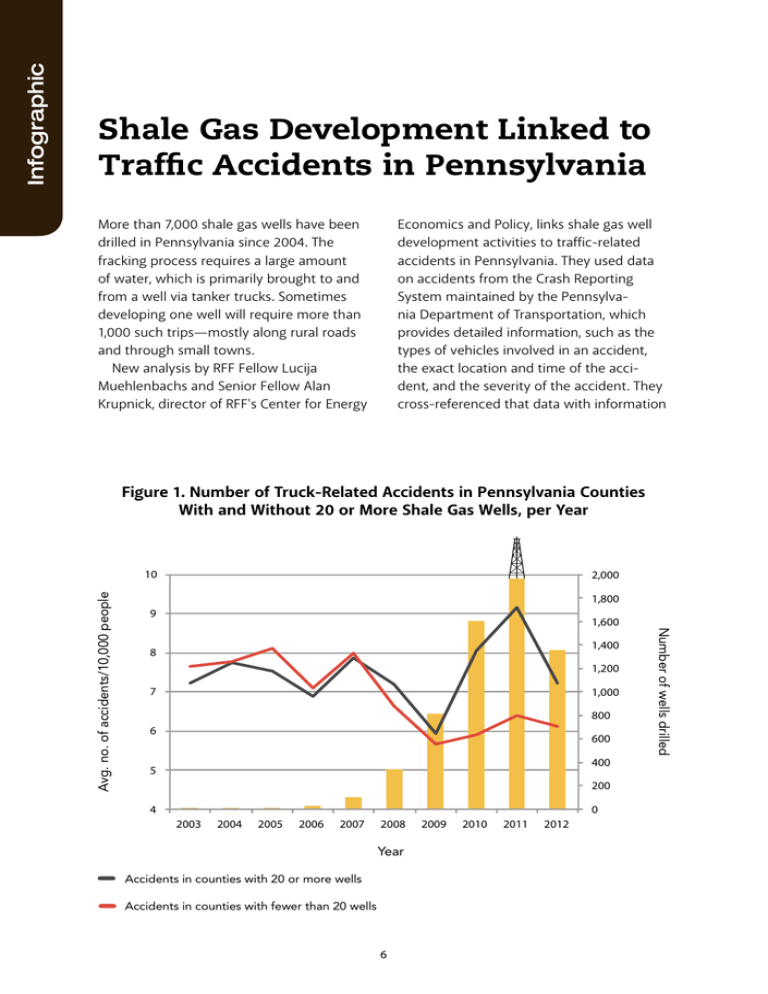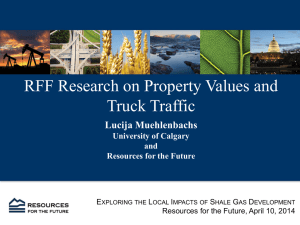Shale Gas Development Linked to Traffic Accidents in Pennsylvania Infographic
advertisement

More than 7,000 shale gas wells have been drilled in Pennsylvania since 2004. The fracking process requires a large amount of water, which is primarily brought to and from a well via tanker trucks. Sometimes developing one well will require more than 1,000 such trips—mostly along rural roads and through small towns. New analysis by RFF Fellow Lucija Muehlenbachs and Senior Fellow Alan Krupnick, director of RFF's Center for Energy Economics and Policy, links shale gas well development activities to traffic-related accidents in Pennsylvania. They used data on accidents from the Crash Reporting System maintained by the Pennsylvania Department of Transportation, which provides detailed information, such as the types of vehicles involved in an accident, the exact location and time of the accident, and the severity of the accident. They cross-referenced that data with information Figure 1. Number of Truck-Related Accidents in Pennsylvania Counties With and Without 20 or More Shale Gas Wells, per Year 10 2,000 1,800 9 1,600 1,400 8 1,200 7 1,000 800 6 600 400 5 200 4 0 2003 2004 2005 2006 2007 2008 Year Accidents in counties with 20 or more wells Accidents in counties with fewer than 20 wells 6 2009 2010 2011 2012 Number of wells drilled Avg. no. of accidents/10,000 people Infographic Shale Gas Development Linked to Traffic Accidents in Pennsylvania Figure 2. Predicted Effects of One Additional Well Drilled per Month per County Impacts on frequency of heavy-duty truck accidents and accidents involving a fatality = 7 2% Heavy-duty truck accidents 0.6% Accidents involving a fatality Infographic These results control for changes in county population, county characteristics, and state-level trends in accident rates over time. With one additional well drilled in a county, the number of accidents involving a fatality increases by 0.6 percent (Figure 2). There are reasons why increased shale gas truck traffic specifically could increase the probability of an accident: there are oil field exemptions from highway safety rules created in the 1960s that allow truckers in the oil and gas industry to work longer hours than drivers in other industries. A study by the Centers for Disease Control and Prevention finds that 27 percent of fatalities among oil and gas extraction workers in the United States from 2003 to 2006 were from highway motor vehicle crashes. Furthermore, it has been shown that an increase in the number of light-duty trucks also increases annual traffic fatalities. A better understanding of the extreme costs (such as accidents and fatalities) associated with shale gas development activity could catalyze attention and resources toward prevention of such accidents in the future. on shale gas wells from the Pennsylvania Department of Environmental Protection and the Department of Conservation and Natural Resources. They find a significant increase in the number of accidents involving a heavy truck in counties with a relatively large degree of shale gas development, as compared with counties with less (or no) development. Figure 1 shows the average number of accidents involving a heavy-duty truck in counties with 20 or more shale gas wells, the same information for counties that have fewer than 20 shale gas wells, and the number of shale gas wells drilled over the same time period throughout the state. There is a high degree of variation in accident rates from year to year, but the lines for both groups of counties move together until shale gas development takes off in 2009–2010. At this point the two accident rates diverge, with far higher accident rates in the counties with more than 20 wells. They also find that one additional well drilled per month raises the frequency of such accidents by approximately 2 percent.








